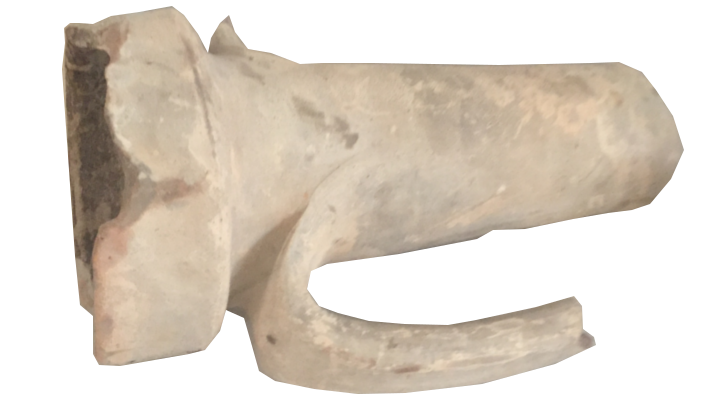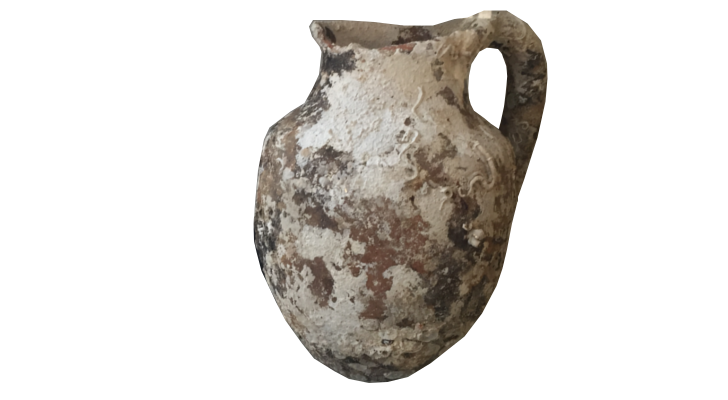A journey under the sea About the VISIT
ViRS Museum expands over a total area of 710 square meters and, as already anticipated in the Home section (The PROJECT), it is organized into a long path composed of 12 areas (separated in six main rooms and six smaller corridors).
Try to pass your mouse over the map below to see it bigger.

The reason of the strumental division between rooms and corridors is to be found in the alternation between:
- the areas that present the real activities (traditional and/or virtual), correlated with artifacts dated 90-100 BC recovered from the shipwreck (i.e. the rooms);
- the areas that carry the storytelling (i.e. the corridors), positioned between the main rooms described in the point above.
Below, the left-image presents the main rooms of the museum, while the image on the right displays the corridors.
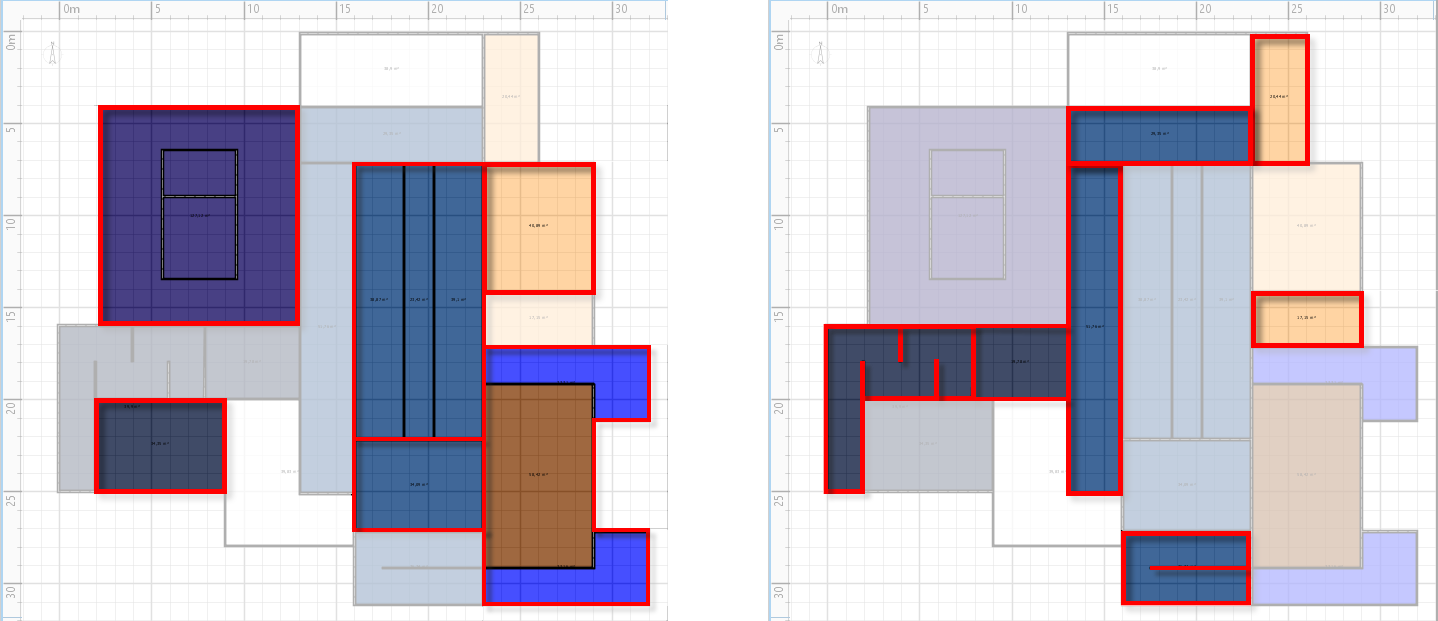
The function of the corridors is of outmost importance, as they present the storytelling that connects all the areas of the museum transforming each of them as a sort of chapter telling part of a lost tale of the sea.
Regarding its definition, as stated in the British Museum guide "Fieldnotes Storytelling",
the storytelling is the act of sharing and shaping stories, in this case drawing links between past, present and future and bringing to life the human presence behind ancient objects.
They, in facts, can be used as anchors and triggers for a huge range of stories, both factual and fictional: in ViRS museum, the storytelling is narrative and
always follows the visitors, from the very first area to the last one. Its core is a love story with uncertain ending: the ancient Roman Captain of the ship that nowadays lays at the bottom of the sea
sails promising his beloved that, when he returns home, he would ask her to marry him. But eventually, the sinking of the ship leaves her alone, watching the sea, without knowing
if he would ever come back, but full of hope and prayers to the Gods.
More about the storytelling of ViRS, the setting, the protagonists and the frames, is displayed at each corridor, down in this page.
As stated in the article "Storytelling: The Real Work of Museums" (Bedford, 2010), stories are powerful because they "do not fill in all the blanks". They open up a space into which the listener’s own feelings, thoughts, and memories can flow and expand, carrying their life experiences and their dreams. They inspire an internal dialogue and thus ensure a real connection. Visitors are thus invited to leave their everyday-life stories, to imagine themselves in an unfamiliar world, where the main question about the wonderful adventure they are experiencing is full of curiosity: how will it end?
Moreover, the connection of the participants to the environment and to the objects in the museum enhances the memorability of the presented information, the creation of stronger emotional bonds with the visitors and the probability of the own re-thinking about the exhibit.

 The entrance does not display any traditional or virtual experiences yet, but nonetheless it can present some artifacts, imagined in the corners of the rectangular-shape room:
they can be few of the Dressel 1B amphorae, the most common type recovered in the ship (more than 700 of them were brought out of the water).
The glass ceiling could be enhanced by interior tensile sails in PVC, which prevent the sun to heat up the room and the visitors, but provide
natural light; a cool modern and navy-like look is also given.
The entrance does not display any traditional or virtual experiences yet, but nonetheless it can present some artifacts, imagined in the corners of the rectangular-shape room:
they can be few of the Dressel 1B amphorae, the most common type recovered in the ship (more than 700 of them were brought out of the water).
The glass ceiling could be enhanced by interior tensile sails in PVC, which prevent the sun to heat up the room and the visitors, but provide
natural light; a cool modern and navy-like look is also given. 

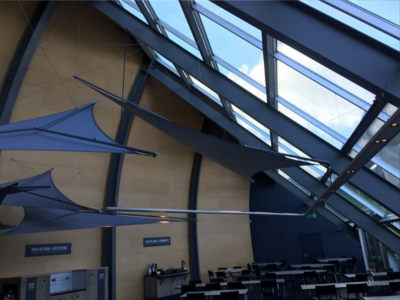


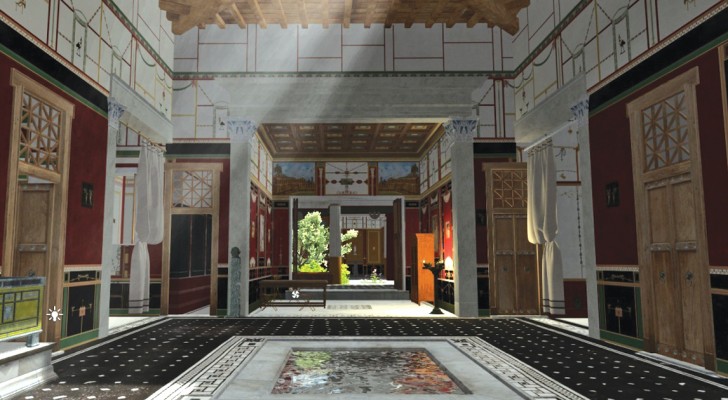
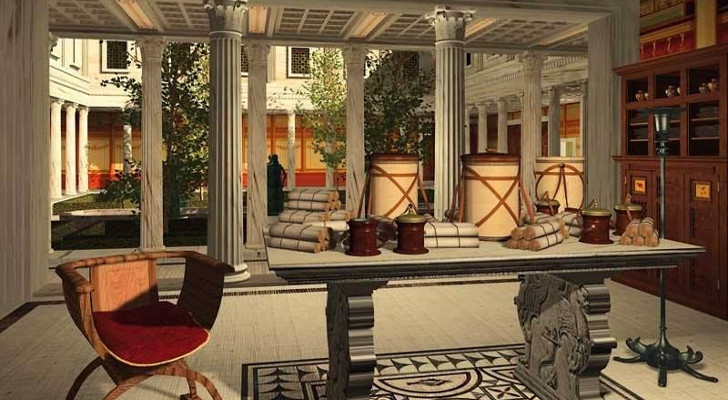
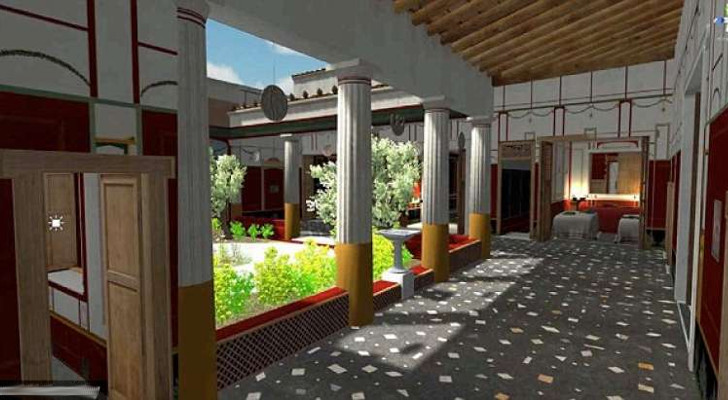
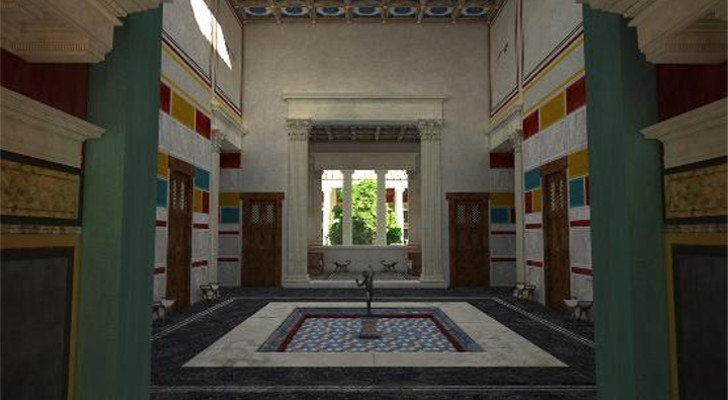
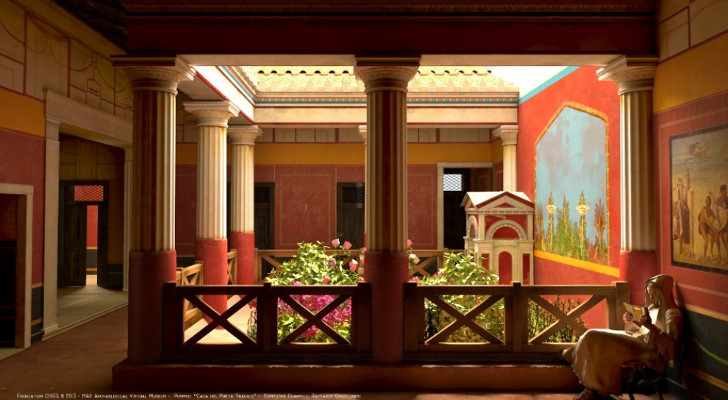
 An hypothesis of the final result can be imagined, thus, as in the .gif below:
An hypothesis of the final result can be imagined, thus, as in the .gif below:
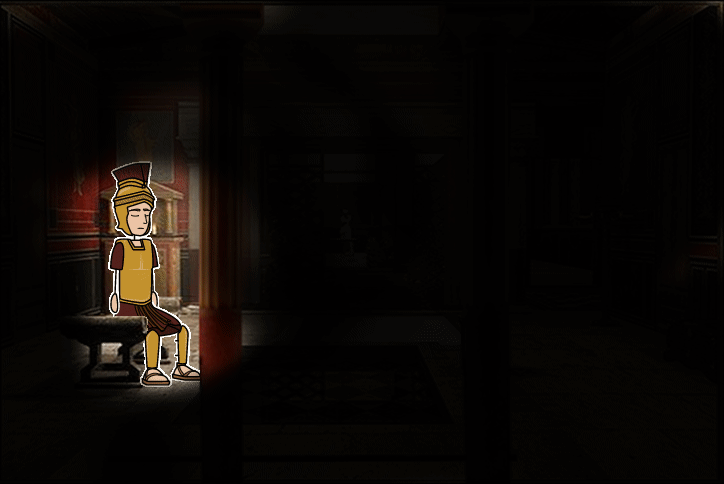 In the example here proposed, the script of the little film is condensed in two lines, with a clear prevalence of the thoughts and feelings of the doubtful captain.
In the example here proposed, the script of the little film is condensed in two lines, with a clear prevalence of the thoughts and feelings of the doubtful captain.


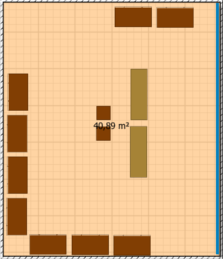 The ambience is thus a serene and hardworking Roman-like port, that has to be imagined as with marble or stone floor and
two simple boxy benches made with the same materials (in the right-image, that displays the disposition of artifacts in the room, the benches are the rectangles in the middle,
indicated with gold color). All around the walls, a various number of glass cases exposes the real artifacts recovered from the wreck:
The ambience is thus a serene and hardworking Roman-like port, that has to be imagined as with marble or stone floor and
two simple boxy benches made with the same materials (in the right-image, that displays the disposition of artifacts in the room, the benches are the rectangles in the middle,
indicated with gold color). All around the walls, a various number of glass cases exposes the real artifacts recovered from the wreck:

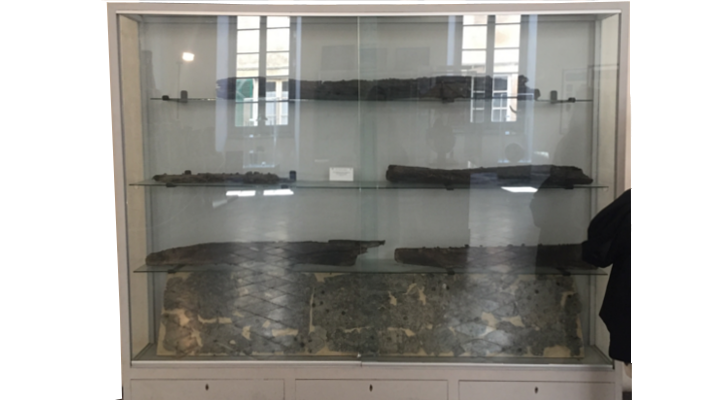




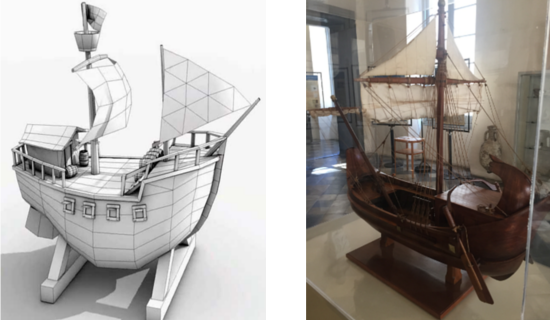
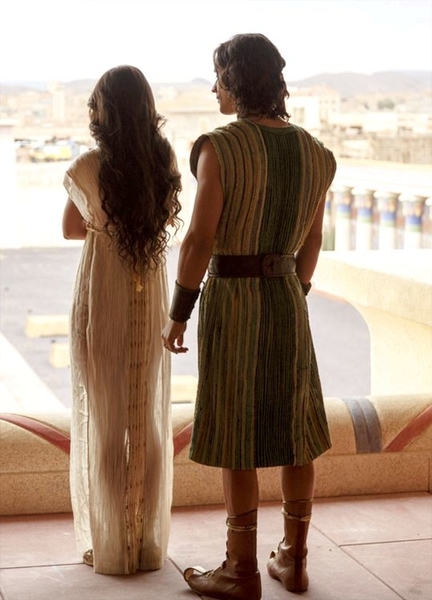
 Evening. Captain Mar-cus confesses that he won’t bring on board Livia, because of the
ominous signs of the Gods. But he doesn’t even want her to worry about his return, so he swears that he will marry her at the return of the journey,
if she promises to wait for him in that place, by the sea.
Evening. Captain Mar-cus confesses that he won’t bring on board Livia, because of the
ominous signs of the Gods. But he doesn’t even want her to worry about his return, so he swears that he will marry her at the return of the journey,
if she promises to wait for him in that place, by the sea.
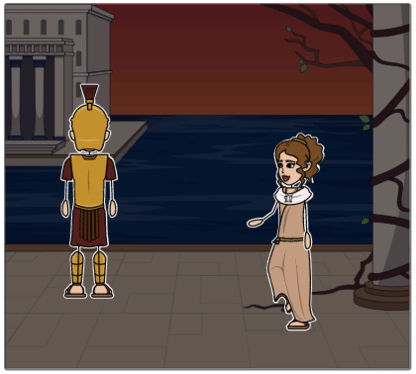

 It is exactly this the atmoshpere that welcomes the visitors, in this
second main room, bigger than the previous one (9 x approx. 14 meters, for a size of 108 sqm); it is the second largest room in the Museum, second only to the 'Underwater'
one. On the left-image its dimension and position are shown with respect to the entire map.
It is exactly this the atmoshpere that welcomes the visitors, in this
second main room, bigger than the previous one (9 x approx. 14 meters, for a size of 108 sqm); it is the second largest room in the Museum, second only to the 'Underwater'
one. On the left-image its dimension and position are shown with respect to the entire map.
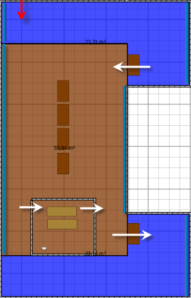 bottom) presented in the image on the right
are characterized by floor-projection of the moving sea, as if the visitors are walking on waves. This is because
they have to reach the brown area, by means of the stairs/wheelchair platform indicated by the first white arrow. The whole brown area is, in fact, a
walkable 1:2 scale reproduction of the cargo ship. One of the main interesting features about it is that the floor is transparent and allows the visitors to see the
view of the amphorae below their feet, placed according to the original arrangement of the load.
The left-figure below shows an example of the disposition of
different types of amphorae (Dressel 1B and two big rounded dolia):
bottom) presented in the image on the right
are characterized by floor-projection of the moving sea, as if the visitors are walking on waves. This is because
they have to reach the brown area, by means of the stairs/wheelchair platform indicated by the first white arrow. The whole brown area is, in fact, a
walkable 1:2 scale reproduction of the cargo ship. One of the main interesting features about it is that the floor is transparent and allows the visitors to see the
view of the amphorae below their feet, placed according to the original arrangement of the load.
The left-figure below shows an example of the disposition of
different types of amphorae (Dressel 1B and two big rounded dolia):

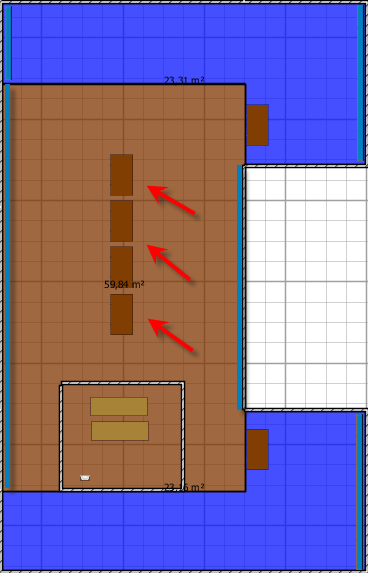 On the glass-floor and in the middle of the ship, several cases exposes different artifacts:
On the glass-floor and in the middle of the ship, several cases exposes different artifacts:
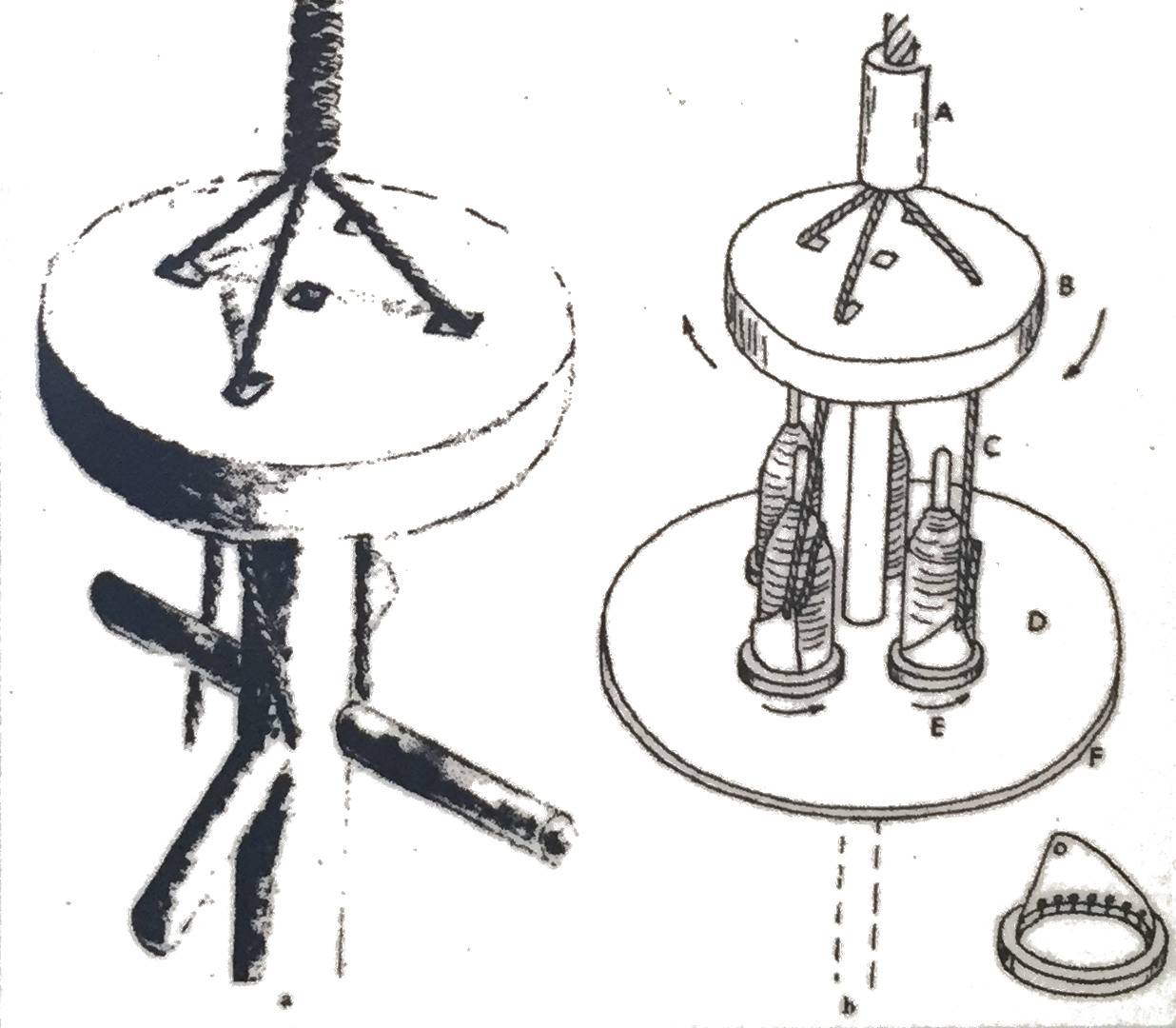
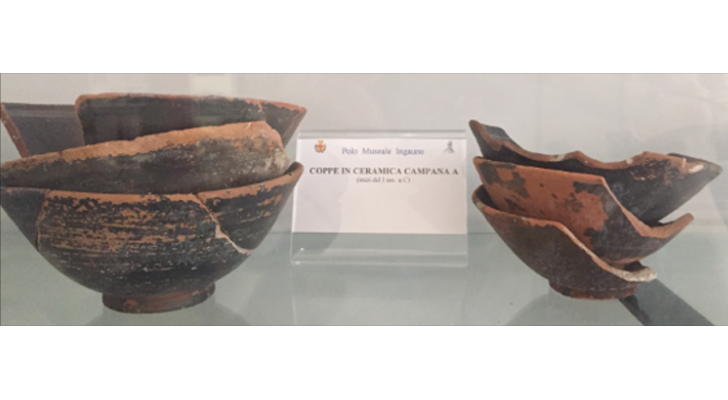

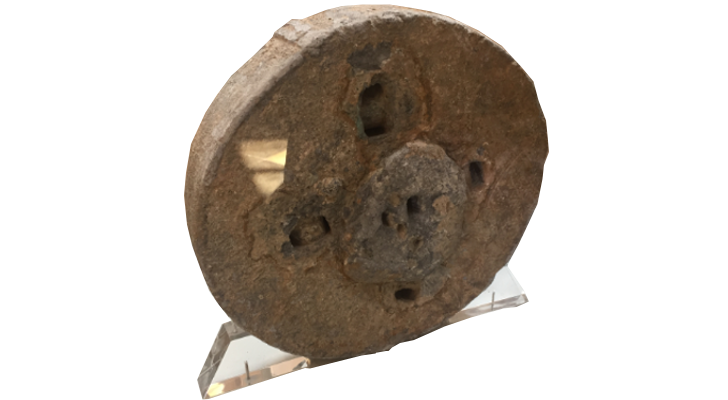

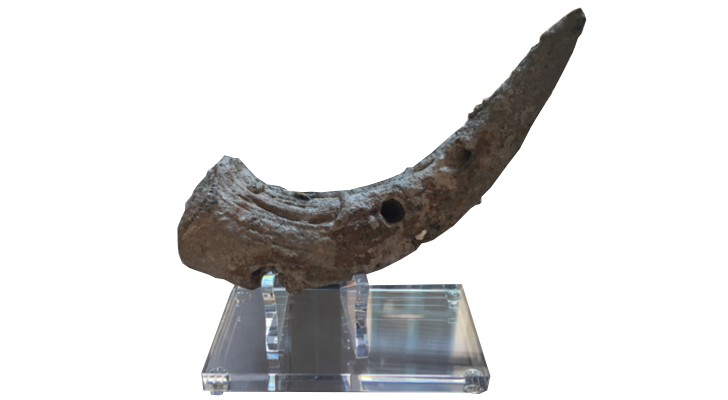
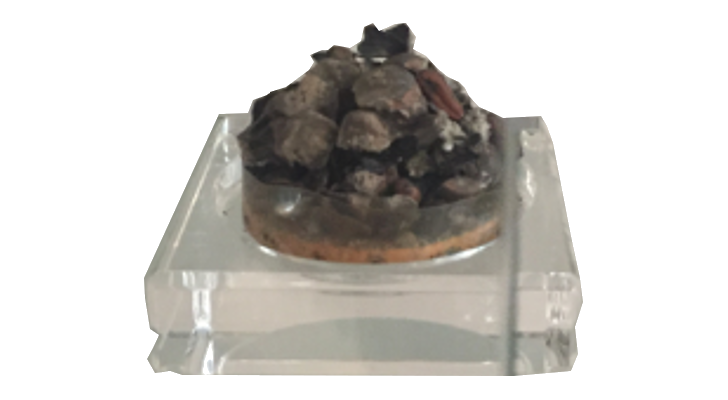
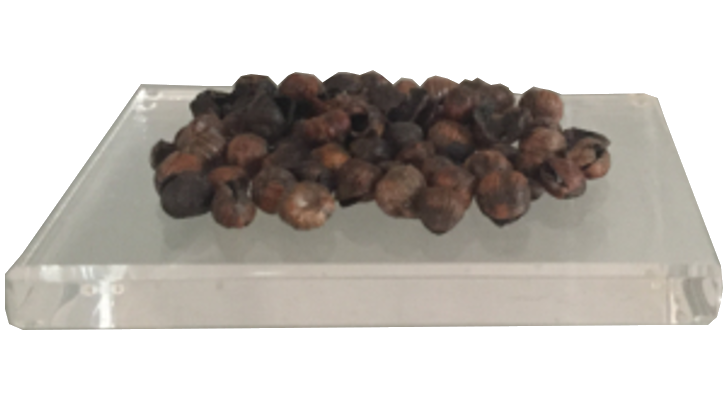
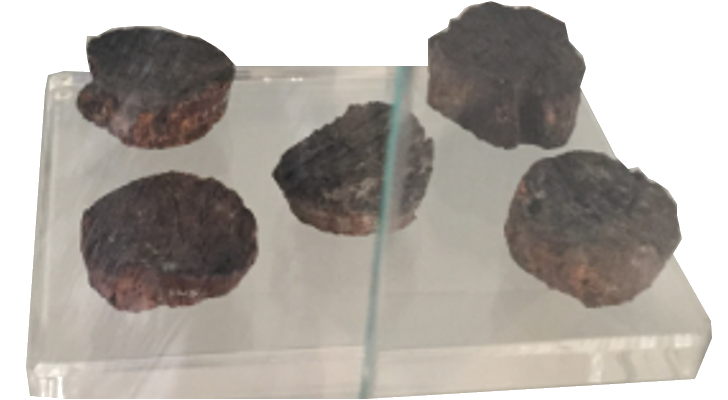
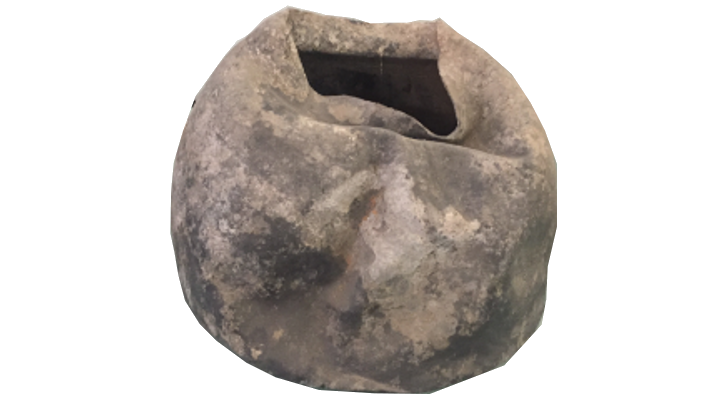
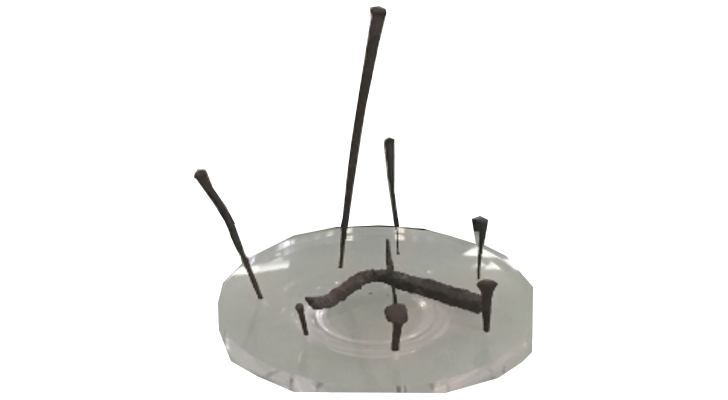
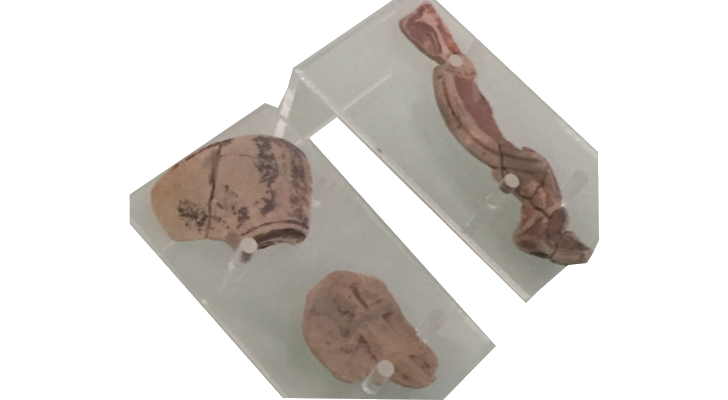
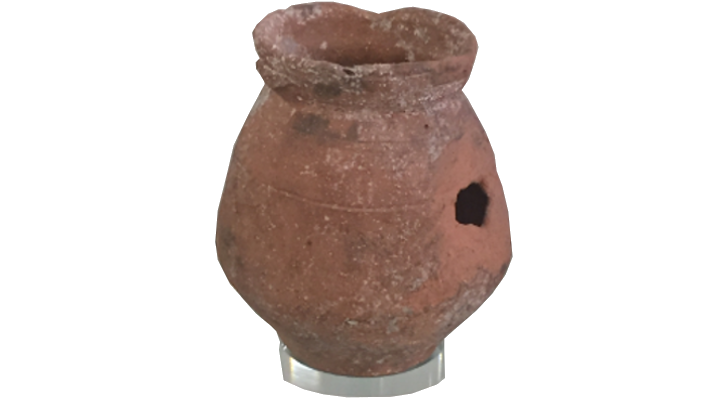

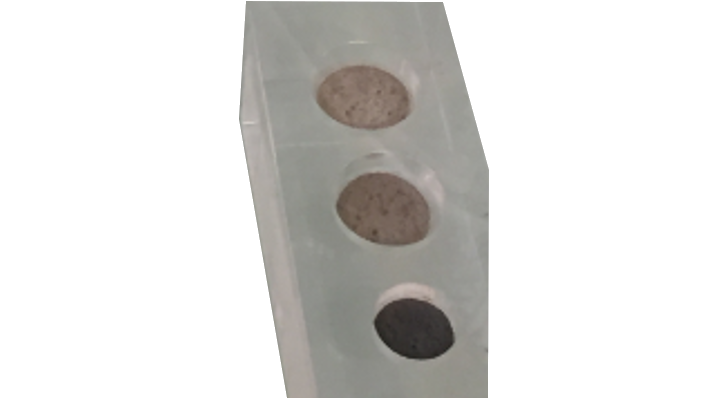
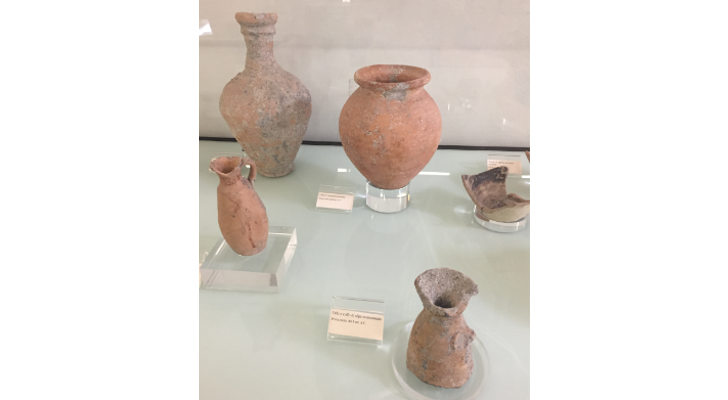
 This room provides also several projections: the aforementioned floor projections of the waves where the visitors can walk before going on the ship reconstruction, but also loop projections
of the horizon and of a light blue and slow-moving sky, on the walls. To make the experience even more real and immersive, ceiling projection of clouds accompany the visitors during their visit
in this room. But it's not over here: for the first time, this room shows a virtual experience, in the shape of gesture-based interactions with the projections on the sides of the ship (
as indicated by the red arrows in the picture on the left): two animations are in fact placed at each side of the ship, in order to continue the spatial projection of the ship to give a bigger and more real sense of spatiality.
The scenes portrayed are four:
This room provides also several projections: the aforementioned floor projections of the waves where the visitors can walk before going on the ship reconstruction, but also loop projections
of the horizon and of a light blue and slow-moving sky, on the walls. To make the experience even more real and immersive, ceiling projection of clouds accompany the visitors during their visit
in this room. But it's not over here: for the first time, this room shows a virtual experience, in the shape of gesture-based interactions with the projections on the sides of the ship (
as indicated by the red arrows in the picture on the left): two animations are in fact placed at each side of the ship, in order to continue the spatial projection of the ship to give a bigger and more real sense of spatiality.
The scenes portrayed are four:
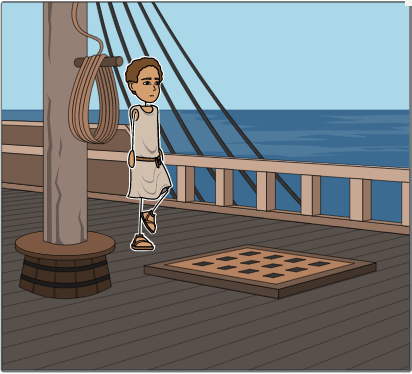

 The reconstruction of the ship not only involves the hull filled with the amphorae, but also the reconstruction of a wooden room: the Captain's cabin.
Benches for seating are provided, where visitors can sit in front of an interactive projection of the Captain Marcus, protagonist of the Museum and of the
whole storytelling, who can be interrogated by means of simple a touchable monitor.
He will thus provide to the audience (meant to be mostly composed of kids and school groups) explanations of:
The reconstruction of the ship not only involves the hull filled with the amphorae, but also the reconstruction of a wooden room: the Captain's cabin.
Benches for seating are provided, where visitors can sit in front of an interactive projection of the Captain Marcus, protagonist of the Museum and of the
whole storytelling, who can be interrogated by means of simple a touchable monitor.
He will thus provide to the audience (meant to be mostly composed of kids and school groups) explanations of:

 Scent of rain and storm surrounds the visitors while entering this corridor, the third one in the map. The atmoshpere is colder, due to fidden fans that simulate
the presence of the wind. From time to time, lightnings enlighten the corridor, full of projections (on all walls and on the ceiling) that show a sea
beginning to be more and more tempestuous.
Scent of rain and storm surrounds the visitors while entering this corridor, the third one in the map. The atmoshpere is colder, due to fidden fans that simulate
the presence of the wind. From time to time, lightnings enlighten the corridor, full of projections (on all walls and on the ceiling) that show a sea
beginning to be more and more tempestuous.
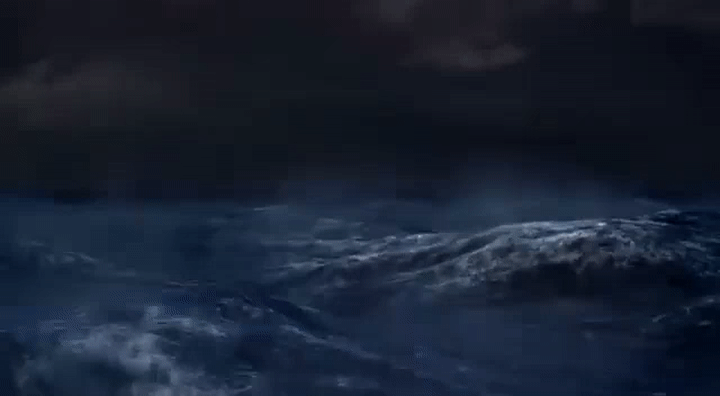
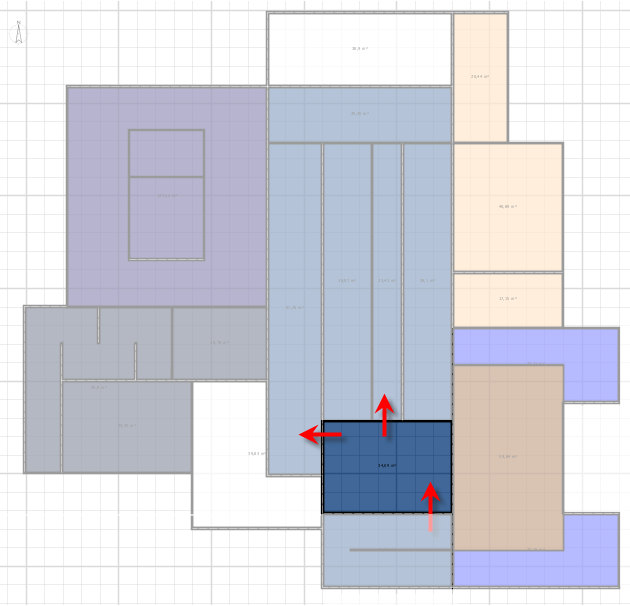 After the last corridor, the visitors have now the feeling that something terrible is going to happen: a huge shipwreck where the Captain Marcus
they have met in all the previous areas could die and leave his beloved Livia alone. This room has the function to carry a little peace before the main
event: a, as the saying goes, "calm before the storm".
After the last corridor, the visitors have now the feeling that something terrible is going to happen: a huge shipwreck where the Captain Marcus
they have met in all the previous areas could die and leave his beloved Livia alone. This room has the function to carry a little peace before the main
event: a, as the saying goes, "calm before the storm".
 It is, in fact, a stand-by room of 35 sqm (7 x 5 meters) before the next area, the 360° VR
theatre, which is open every 9 minutes. For this
reasons, it is shrouded in silence, with no projections, and has got some benches on the North and East-sides (indicated by the gold rectangles
in the image below). One person from the staff is
exceptionally needed to control and regulate
the entrance of the visitors to the next room. The same person can also help users with the main activity of this area: the AR reconstruction of broken artifacts,
situated on the South-West side (in the picture on the left, the cases which contain the artifacts are the dark-brown rectangles).
It is, in fact, a stand-by room of 35 sqm (7 x 5 meters) before the next area, the 360° VR
theatre, which is open every 9 minutes. For this
reasons, it is shrouded in silence, with no projections, and has got some benches on the North and East-sides (indicated by the gold rectangles
in the image below). One person from the staff is
exceptionally needed to control and regulate
the entrance of the visitors to the next room. The same person can also help users with the main activity of this area: the AR reconstruction of broken artifacts,
situated on the South-West side (in the picture on the left, the cases which contain the artifacts are the dark-brown rectangles).
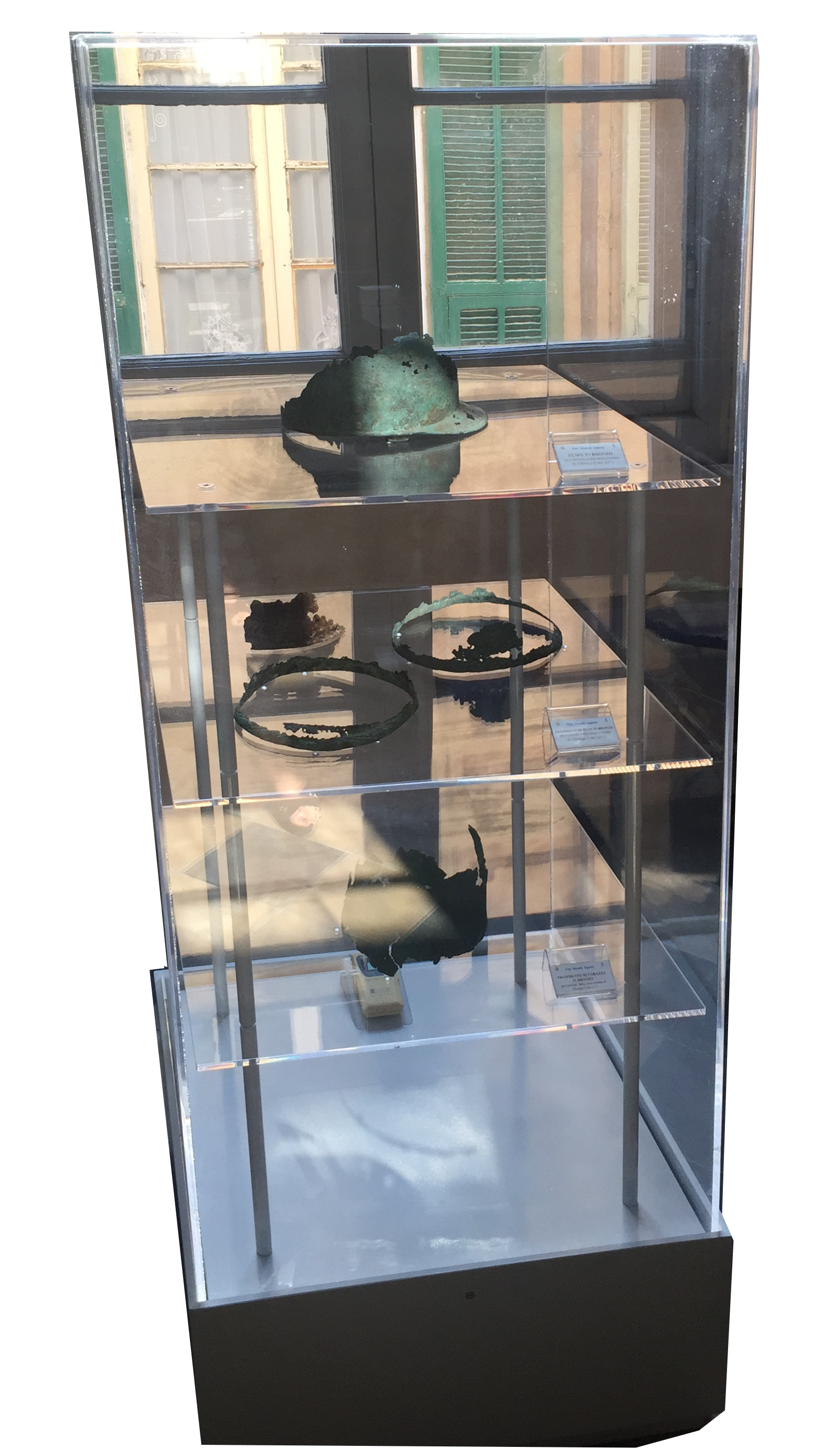 In 1950 and later in 1962, eight bronze helmets and several pieces of armors were found in the Albenga wreck. This type of finding had led to the supposition
that a cargo ship of that size could require an armed military guard, unless the helmets were part of the normal on-board equipment, to be used for protection in cases
of attack by pirates or other enemies, which at the beginning of the first century BC had to be particularly frequent. The intensification of underwater researches and
archaeological discoveries has now shown that the presence of helmets on board was a very recurrent fact, especially on the wrecks of the first century BC.
Moreover, the fact that helmets found on the same ship present rather remarkable differences between them makes one think more of an improvised army than of a real and stable
military guard.
In 1950 and later in 1962, eight bronze helmets and several pieces of armors were found in the Albenga wreck. This type of finding had led to the supposition
that a cargo ship of that size could require an armed military guard, unless the helmets were part of the normal on-board equipment, to be used for protection in cases
of attack by pirates or other enemies, which at the beginning of the first century BC had to be particularly frequent. The intensification of underwater researches and
archaeological discoveries has now shown that the presence of helmets on board was a very recurrent fact, especially on the wrecks of the first century BC.
Moreover, the fact that helmets found on the same ship present rather remarkable differences between them makes one think more of an improvised army than of a real and stable
military guard.
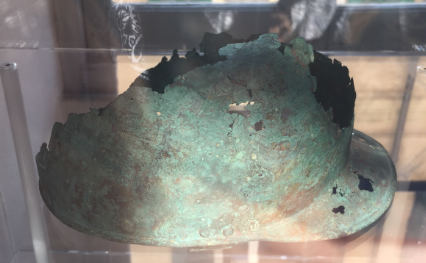

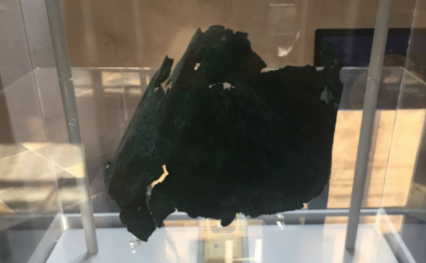
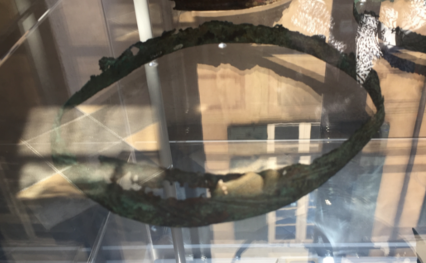
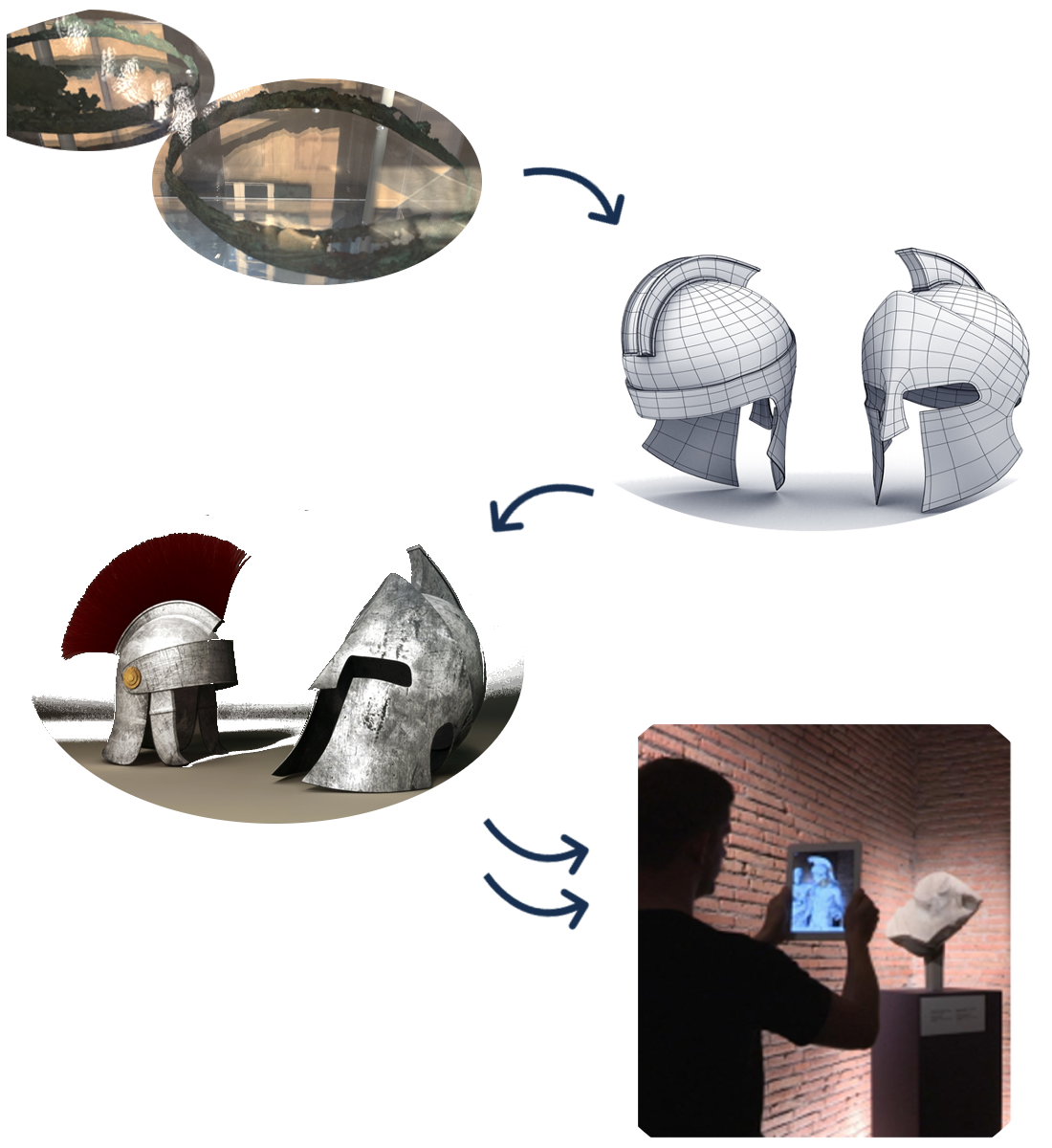


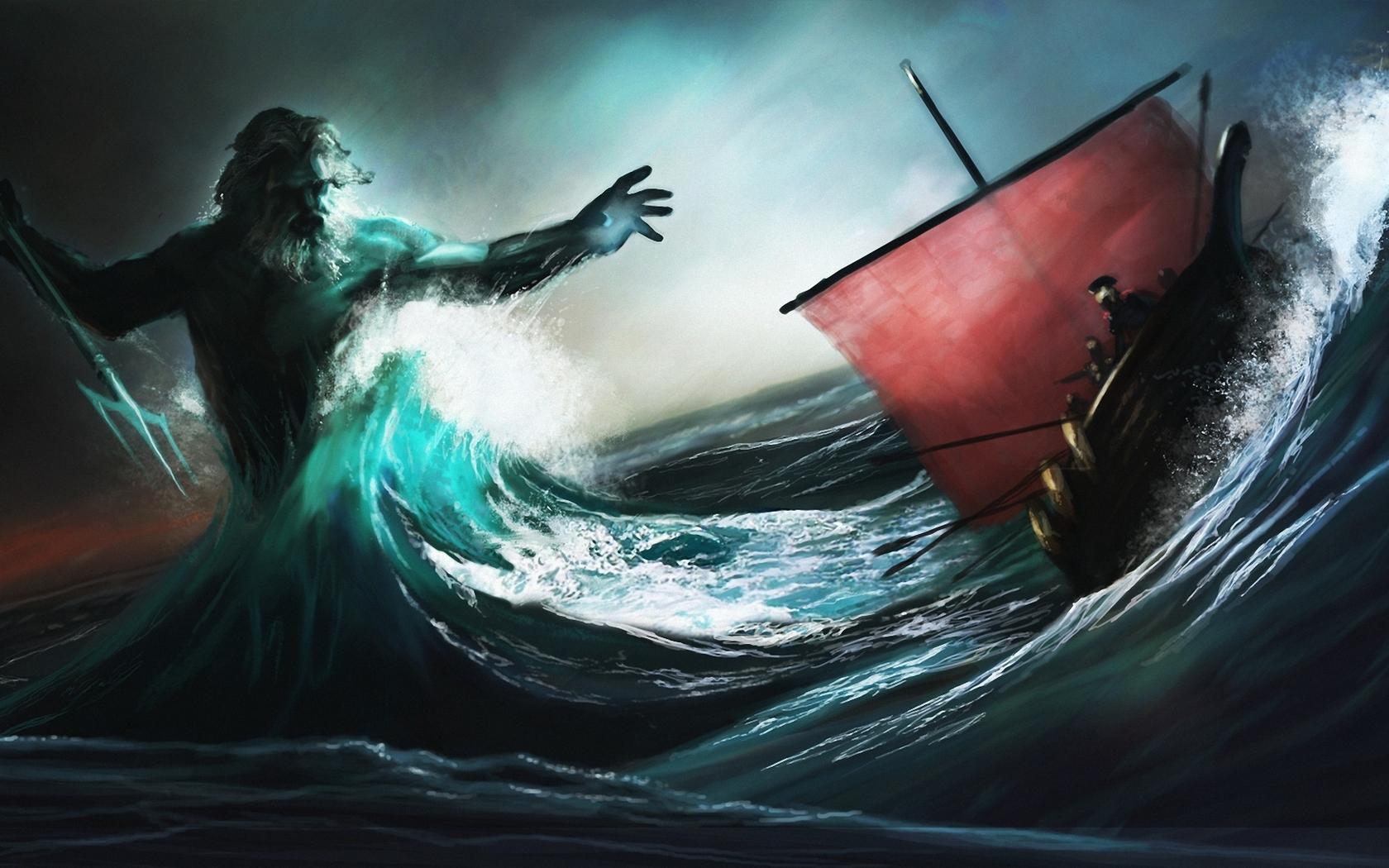 The subject of
the 360° projection is the shipwreck: the visitors will experience the ship and its crew fight against the huge waves of the sea, moving from the left wall to the right one,
at the mercy of Neptune's capricious and unpredictable will. The involvement and the participation of the visitors is also enhanced by the presence of little hiddle fans that,
once again like in the corridor
The subject of
the 360° projection is the shipwreck: the visitors will experience the ship and its crew fight against the huge waves of the sea, moving from the left wall to the right one,
at the mercy of Neptune's capricious and unpredictable will. The involvement and the participation of the visitors is also enhanced by the presence of little hiddle fans that,
once again like in the corridor
 '
' fear, uncomfortableness or unpleasant symptoms.
Nonetheless, people with physical disabylities or in wheelchair can experience it, since the corridor has an appropriate width (approx. 2 meters).
fear, uncomfortableness or unpleasant symptoms.
Nonetheless, people with physical disabylities or in wheelchair can experience it, since the corridor has an appropriate width (approx. 2 meters).
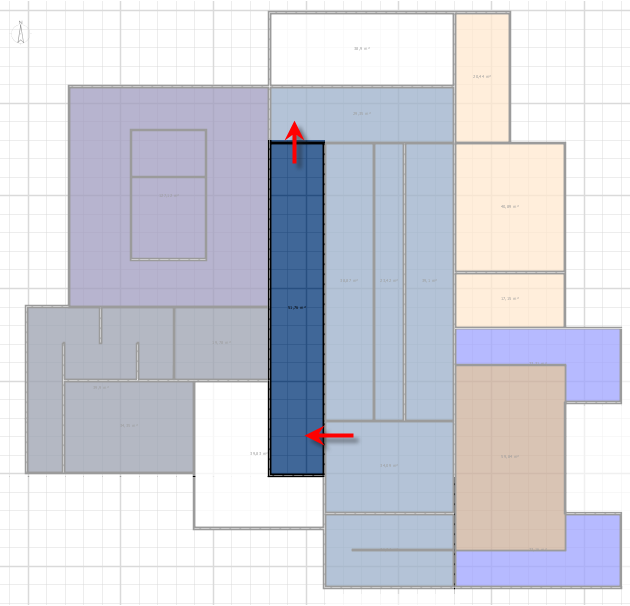 This corridor has been tought for all the visitors that, for the most varied reasons, can't or don't want to experience the thrilling 360° immersive theatre of the
sinking of the ship. As already mentioned in the dedicated section, in fact, it is not suitable for vertigo-sufferers, kids under 6 years-old and elderly visitors.
But this corridor is also designed for people with special needs: storm sounds and seamen's voices help visually impaired people to enter into the
atmoshpere of the sinking, while the explanatory panels in braille clarify what it's happening. The corridor, 3 x 18 meters,
has a total area of 54 sqm.
This corridor has been tought for all the visitors that, for the most varied reasons, can't or don't want to experience the thrilling 360° immersive theatre of the
sinking of the ship. As already mentioned in the dedicated section, in fact, it is not suitable for vertigo-sufferers, kids under 6 years-old and elderly visitors.
But this corridor is also designed for people with special needs: storm sounds and seamen's voices help visually impaired people to enter into the
atmoshpere of the sinking, while the explanatory panels in braille clarify what it's happening. The corridor, 3 x 18 meters,
has a total area of 54 sqm.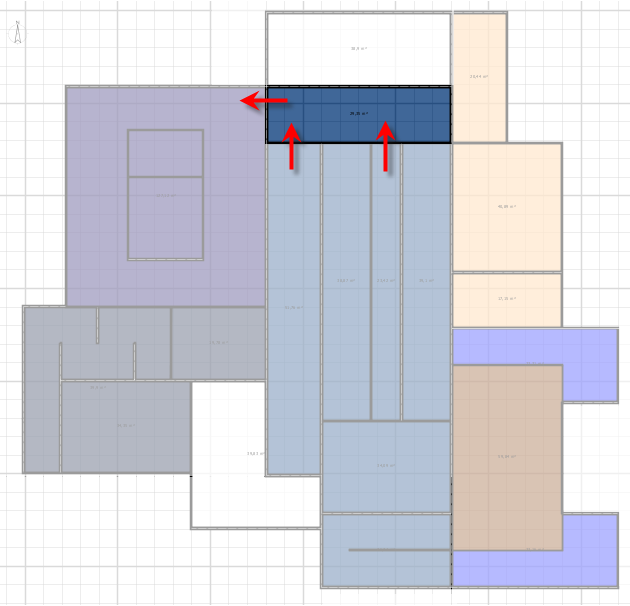 This is a simple corridor with no activities, storytelling or artifacts, that measures 10 m x 3 (for a total of 30 sqm). Its function is just to show the path,
which is progressively going underwater after the '
This is a simple corridor with no activities, storytelling or artifacts, that measures 10 m x 3 (for a total of 30 sqm). Its function is just to show the path,
which is progressively going underwater after the '


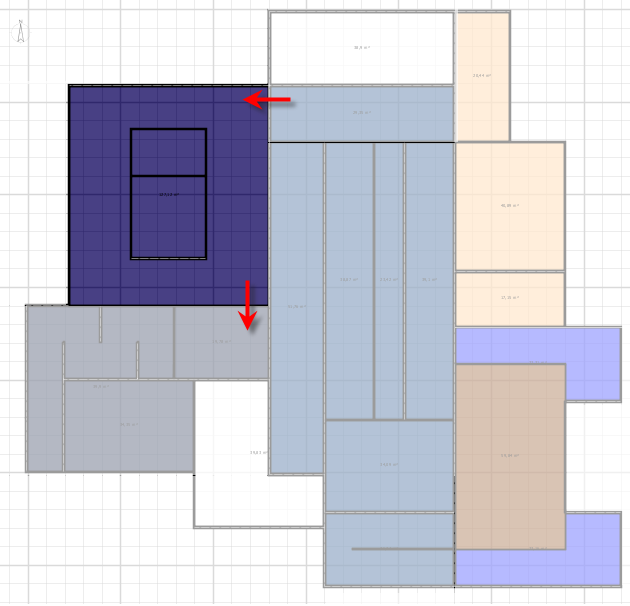
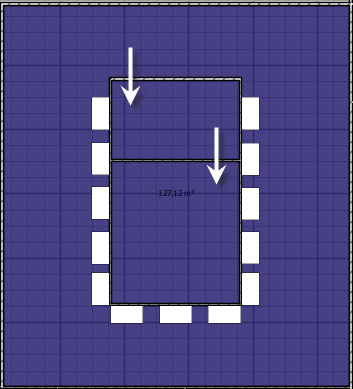

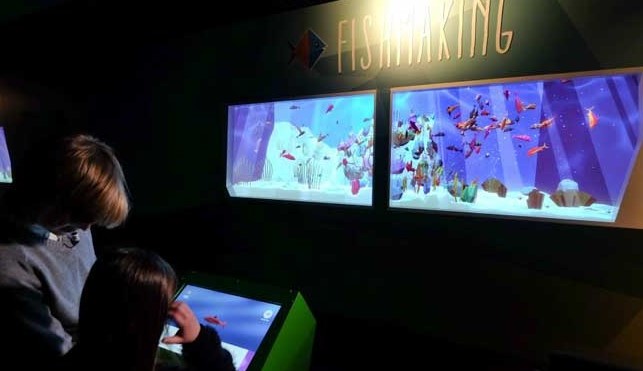
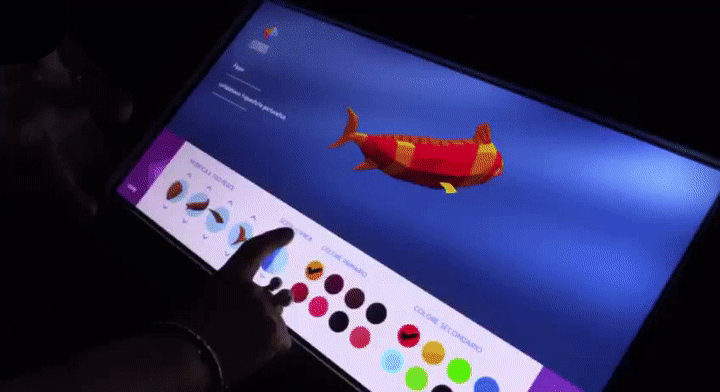
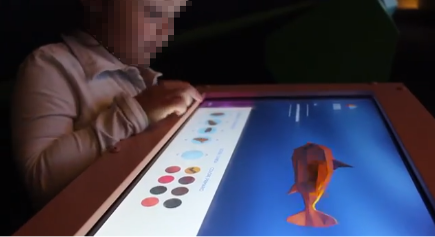
 In addition to the Fish-making activity, the ViRS Museum also promotes an Amphorae-making experience, by means of the same consoles and touch screens of the Fish-making:
in this game, the users have to shape and customize their own amphora, among the different possibilities, all accompanied by the real archaeological type and name.
The reference
table is the 'Amphora typology sketch' provided in the image on the right, made by
In addition to the Fish-making activity, the ViRS Museum also promotes an Amphorae-making experience, by means of the same consoles and touch screens of the Fish-making:
in this game, the users have to shape and customize their own amphora, among the different possibilities, all accompanied by the real archaeological type and name.
The reference
table is the 'Amphora typology sketch' provided in the image on the right, made by 
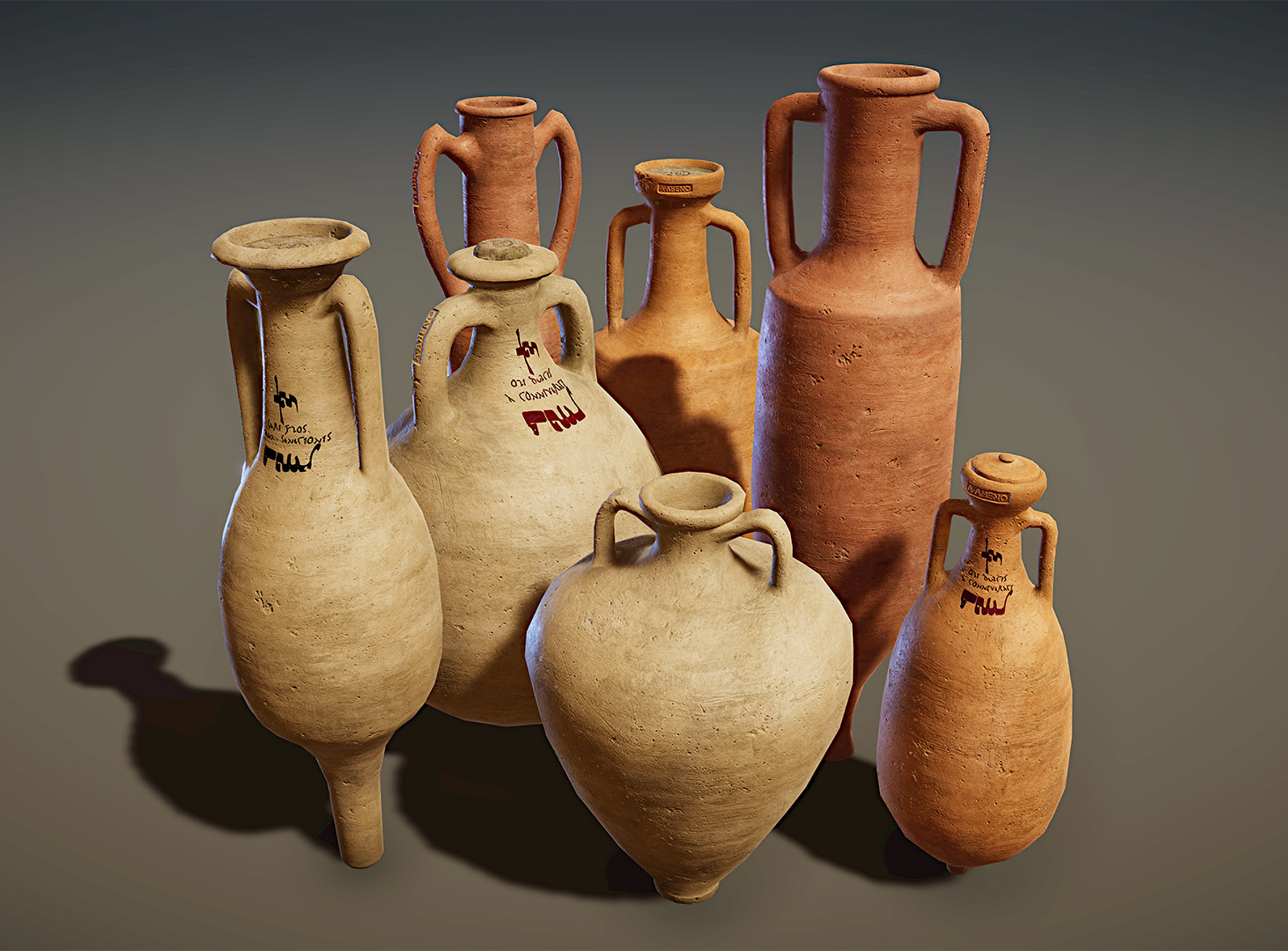
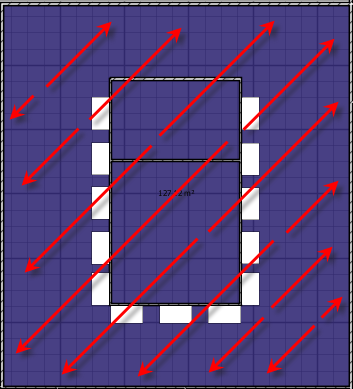
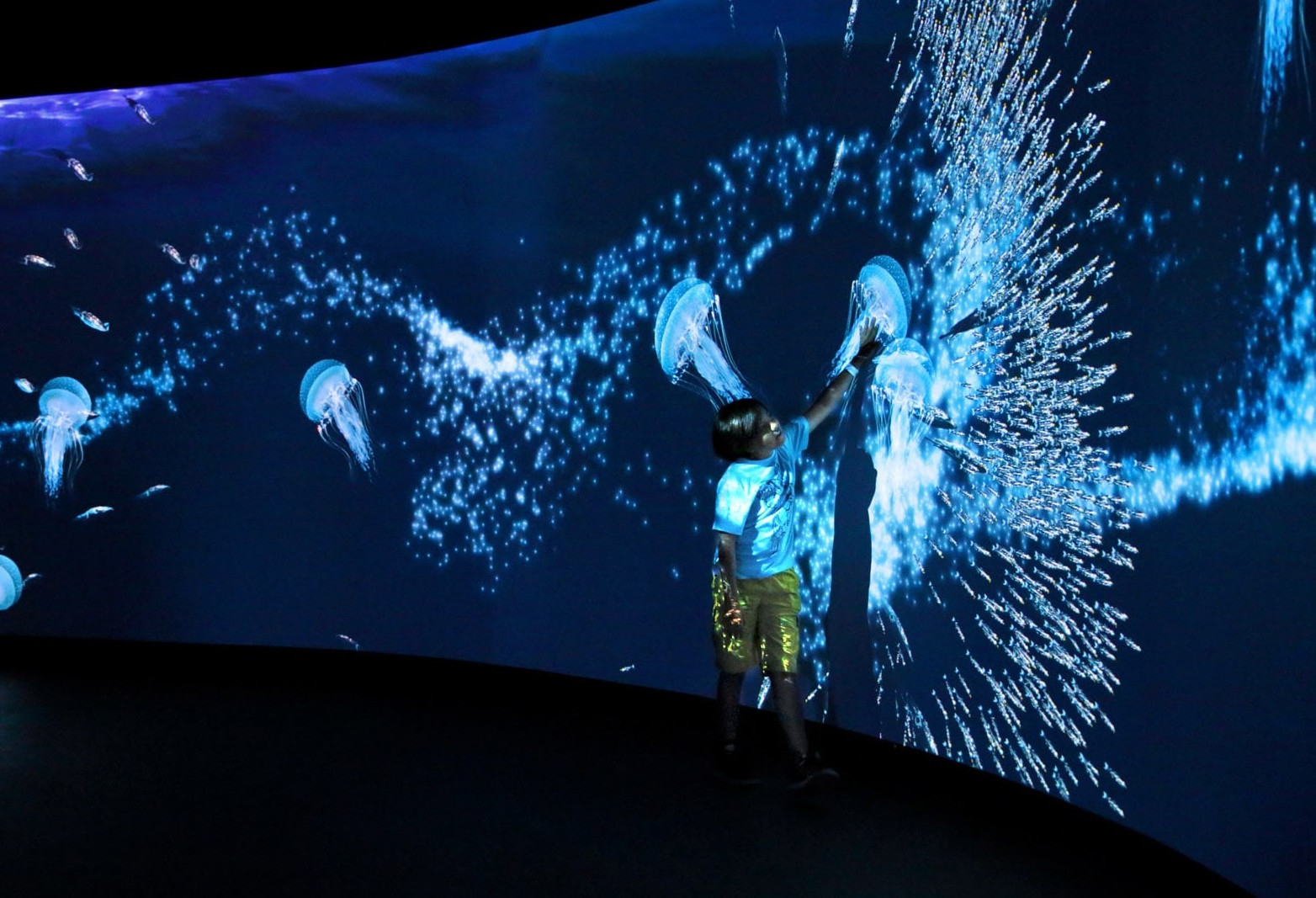
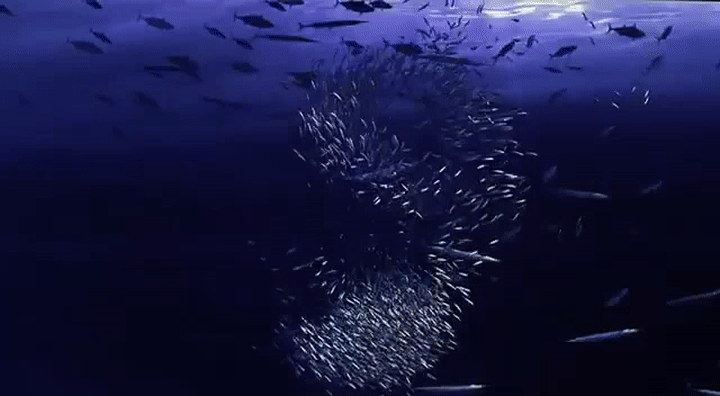
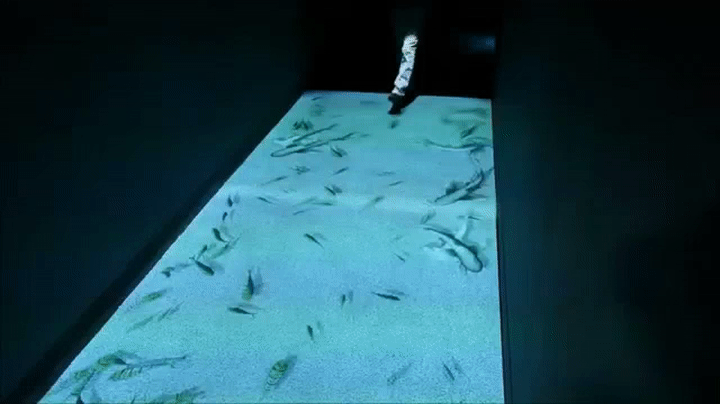 The floor is occupied by a projection, as well. Here there are only default items (i.e. it is not possible to add customize amphorae or fish by the users): seaweed,
rocks, broken amphorae, fish. The movement sensors for the creatures are provided as well, in order to replicate the realistic environment already
promoted by the surrounding projections on the walls.
The floor is occupied by a projection, as well. Here there are only default items (i.e. it is not possible to add customize amphorae or fish by the users): seaweed,
rocks, broken amphorae, fish. The movement sensors for the creatures are provided as well, in order to replicate the realistic environment already
promoted by the surrounding projections on the walls.
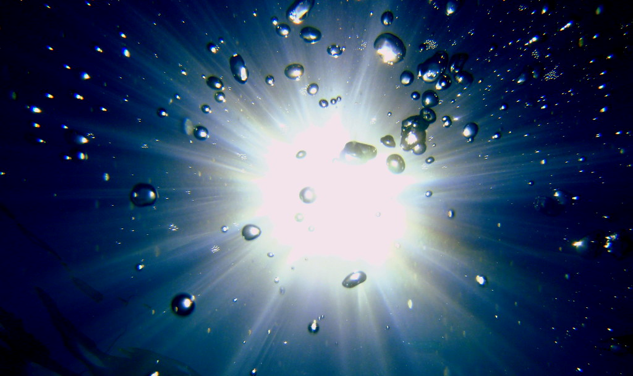
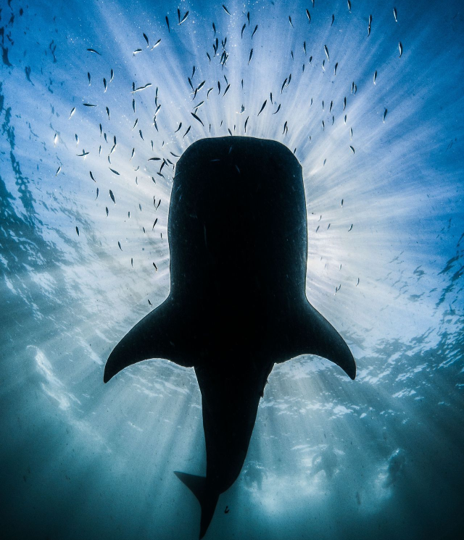 Occasionally, a predator like a shark or another
big Mediterranean creature like a moonfish or a manta (mobula mediterranea)
crosses the ceiling, arousing the astonishment of the visitors, especially the younger ones.
Ideally, one of these large animals should pass every 15 minutes, that is the time that is certainly spent by each visitor inside the room, and that can easily be
waited (30 minutes) in the case a return of another shark is desired.
Occasionally, a predator like a shark or another
big Mediterranean creature like a moonfish or a manta (mobula mediterranea)
crosses the ceiling, arousing the astonishment of the visitors, especially the younger ones.
Ideally, one of these large animals should pass every 15 minutes, that is the time that is certainly spent by each visitor inside the room, and that can easily be
waited (30 minutes) in the case a return of another shark is desired.
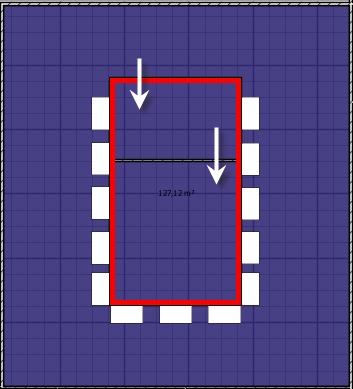

 The target users are four at a time, and they must be at least nine years old (for safety reasons), and the game can also be experienced by visitors in wheelchairs. Each session is composed by
four different steps:
The target users are four at a time, and they must be at least nine years old (for safety reasons), and the game can also be experienced by visitors in wheelchairs. Each session is composed by
four different steps:
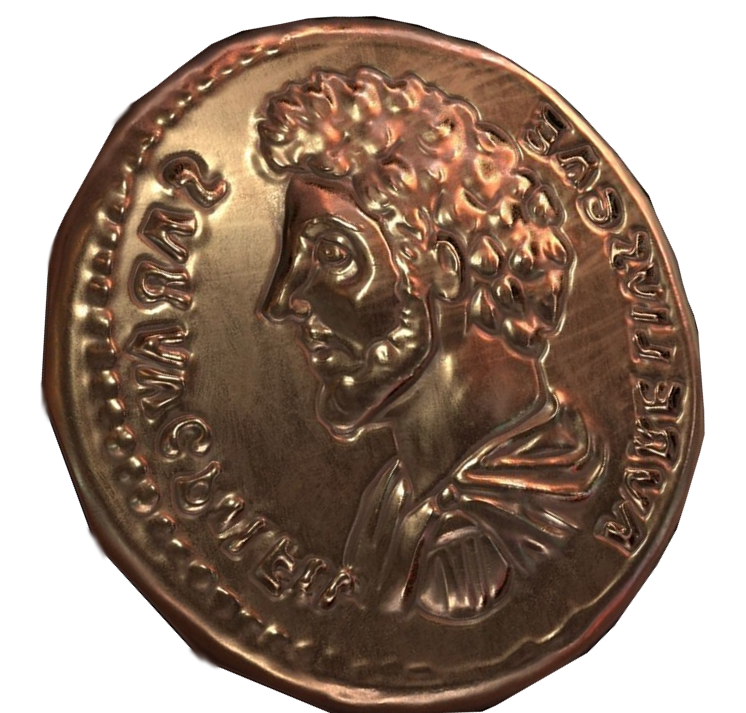

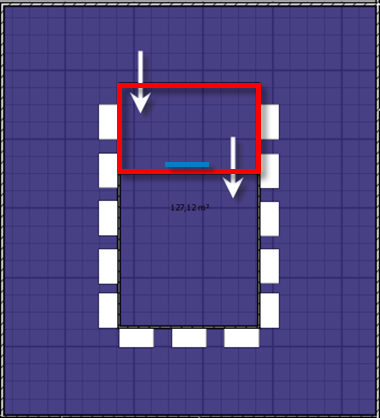 The tutorial is made on a LCD screen (the little and horizontal light blue line in the right-image) in the first part of the glass room.
The Captain Marcus is alone in the sea, clinging to a wooden plank. He addresses to the four players as “creatures sent by the gods” because of their strange clothes
and beg them to bring him Livia’s wedding ring.
He doesn't explain how to move the controllers (it would be logically impossible since he has never seen before the visitors’ equipment): this is up to the staff.
The tutorial is made on a LCD screen (the little and horizontal light blue line in the right-image) in the first part of the glass room.
The Captain Marcus is alone in the sea, clinging to a wooden plank. He addresses to the four players as “creatures sent by the gods” because of their strange clothes
and beg them to bring him Livia’s wedding ring.
He doesn't explain how to move the controllers (it would be logically impossible since he has never seen before the visitors’ equipment): this is up to the staff.
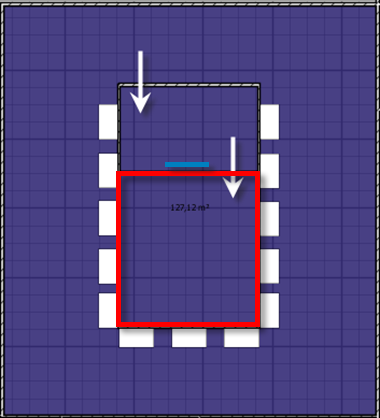 The game is single-player but with multi-player visualization (i.e. the other participants’ avatars are shown in the game).
The goal is to find Livia's wedding ring, so that Captain Marcus can marry her, once back home.
The position of the ring in the site is casually recreated each time the players start a new game, to ensure unpredictability and the possibility of users
to try again the game. There is the possibility to grasp the ring, by means of the controllers, but also rocks and pieces of woods that lay on the seabed.
The game is single-player but with multi-player visualization (i.e. the other participants’ avatars are shown in the game).
The goal is to find Livia's wedding ring, so that Captain Marcus can marry her, once back home.
The position of the ring in the site is casually recreated each time the players start a new game, to ensure unpredictability and the possibility of users
to try again the game. There is the possibility to grasp the ring, by means of the controllers, but also rocks and pieces of woods that lay on the seabed.
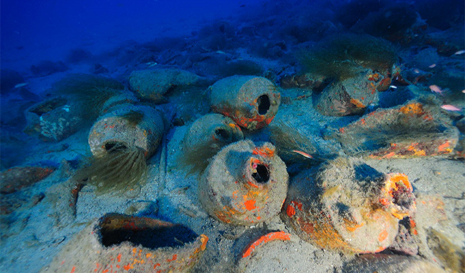 The game scenario has a realistic representation:
it is composed by the ship, unreachable and on the background, lying on the sand, and a real-life representation of the actual disposition of the amphorae, the one that
nowadays is situated 1.5 km from the coast of Albenga, and is depicted in the image on the right. Different kinds of Mediterranean fish
populate the scenario, among with seaweed. There aren’t dangerous creatures.
The game scenario has a realistic representation:
it is composed by the ship, unreachable and on the background, lying on the sand, and a real-life representation of the actual disposition of the amphorae, the one that
nowadays is situated 1.5 km from the coast of Albenga, and is depicted in the image on the right. Different kinds of Mediterranean fish
populate the scenario, among with seaweed. There aren’t dangerous creatures.

 The headset that had been chosen for the game is the
The headset that had been chosen for the game is the 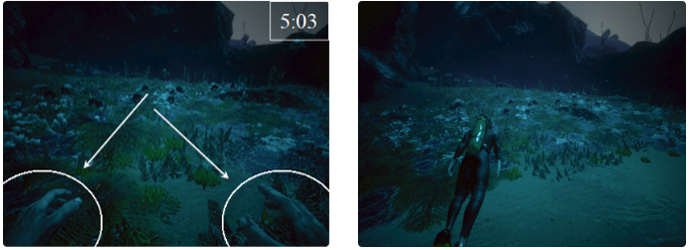
 When one of the player has found the ring, they all can choose to remain in the game and explore the area until the timer counts zero.
When one of the player has found the ring, they all can choose to remain in the game and explore the area until the timer counts zero.

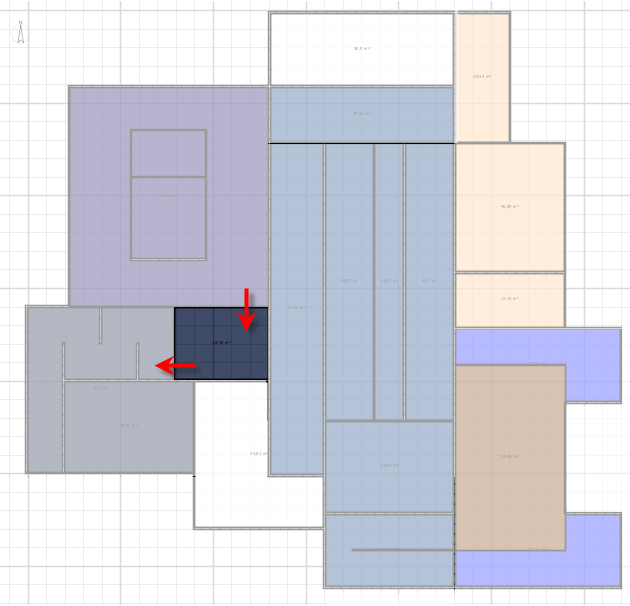 This area is occupied by a big projection of Livia, the Captain's beloved, home, watching the sea in the exact setting portrayed in the '
This area is occupied by a big projection of Livia, the Captain's beloved, home, watching the sea in the exact setting portrayed in the '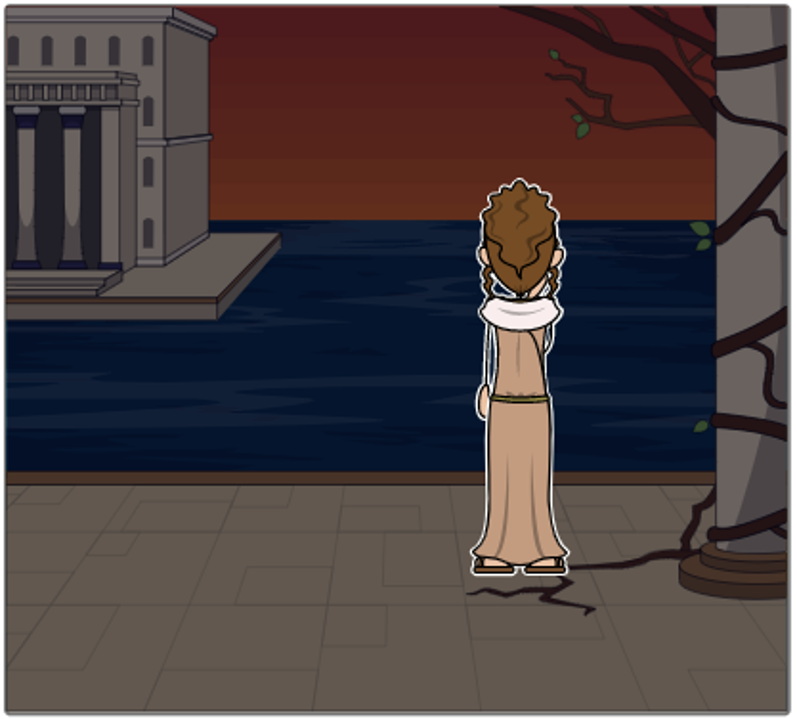
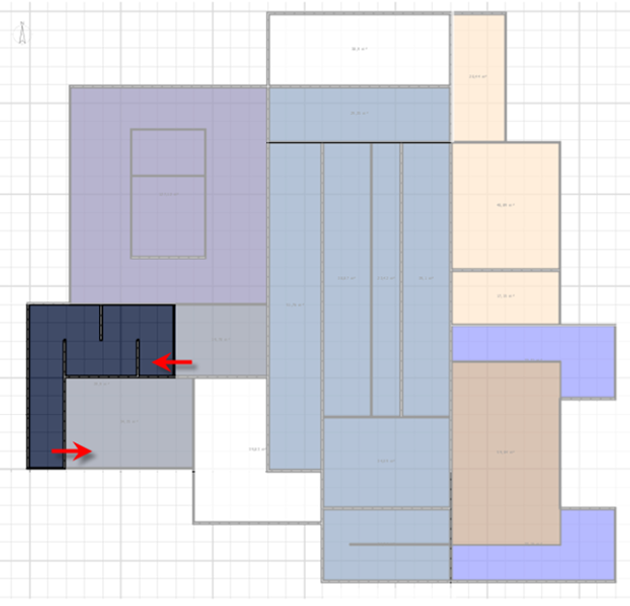 This area (42 sqm) is dedicated to a series of explanatory panels that progressively show the deterioration of the underwater ship. In this way, the visitors are gently transported away
from the 100BC, in order to return to present days.
As Paul Beilstein, from the Underwater Archaeological Society of British Columbia,
This area (42 sqm) is dedicated to a series of explanatory panels that progressively show the deterioration of the underwater ship. In this way, the visitors are gently transported away
from the 100BC, in order to return to present days.
As Paul Beilstein, from the Underwater Archaeological Society of British Columbia, 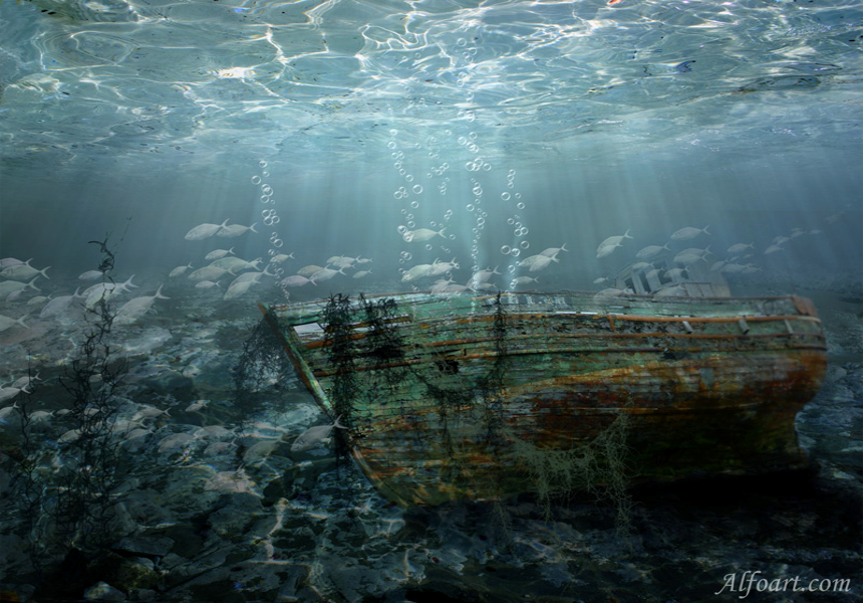

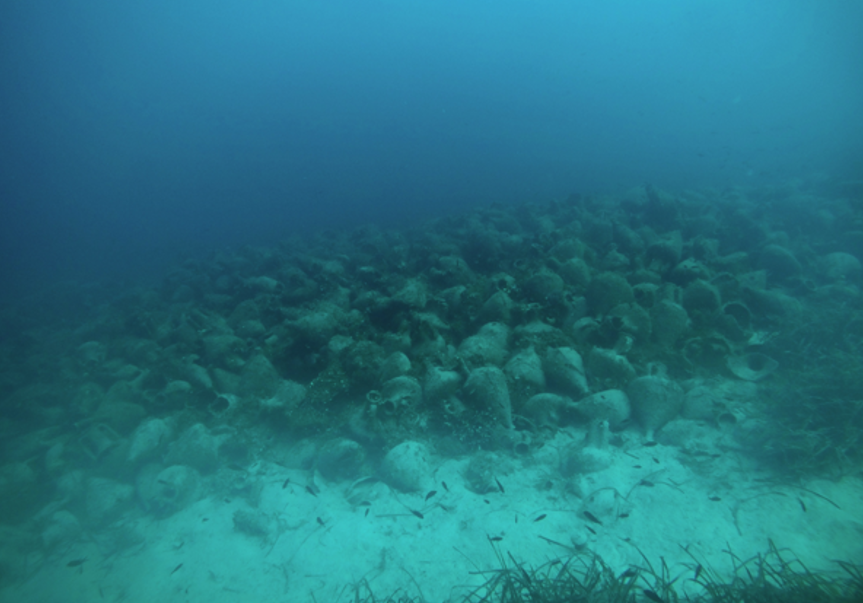
 On the left, moreover, a little drawing taken as a photograph
from the Roman Naval Museum of Albenga
illustrates how much of the Albenga's shipwreck is still located under the bottom of the sea, waiting to be unearthed
and brought to light in possible future archaeological excavations and researches. The only part that has been digged until now, in fact, is the one coloured in dark red, on the left of the image.
On the left, moreover, a little drawing taken as a photograph
from the Roman Naval Museum of Albenga
illustrates how much of the Albenga's shipwreck is still located under the bottom of the sea, waiting to be unearthed
and brought to light in possible future archaeological excavations and researches. The only part that has been digged until now, in fact, is the one coloured in dark red, on the left of the image.
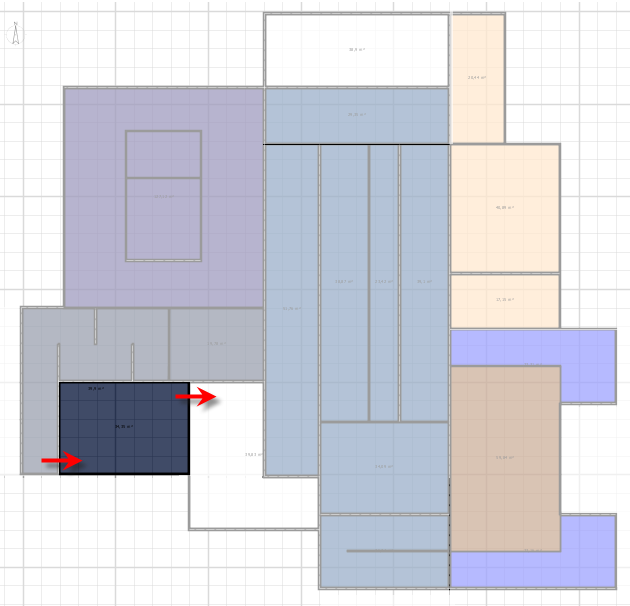 The last room (35 sqm, 7 x 5 meters) before the exit and shop area is rooted in the present days and in the ways that have been experienced by underwater archaeologists to bring to
light a part of the Albenga's shipwreck. An underwater excavation game for kids, with water, sand and fake artifacts, is thus the main activity of the room, to teach the delicacy and
the difficulty of a task like the underwater recovery of a millennial ship. No virtual activities are provided in this area, dedicated only to real
artifacts and panels explaining the recovery of the wreck.
The last room (35 sqm, 7 x 5 meters) before the exit and shop area is rooted in the present days and in the ways that have been experienced by underwater archaeologists to bring to
light a part of the Albenga's shipwreck. An underwater excavation game for kids, with water, sand and fake artifacts, is thus the main activity of the room, to teach the delicacy and
the difficulty of a task like the underwater recovery of a millennial ship. No virtual activities are provided in this area, dedicated only to real
artifacts and panels explaining the recovery of the wreck.

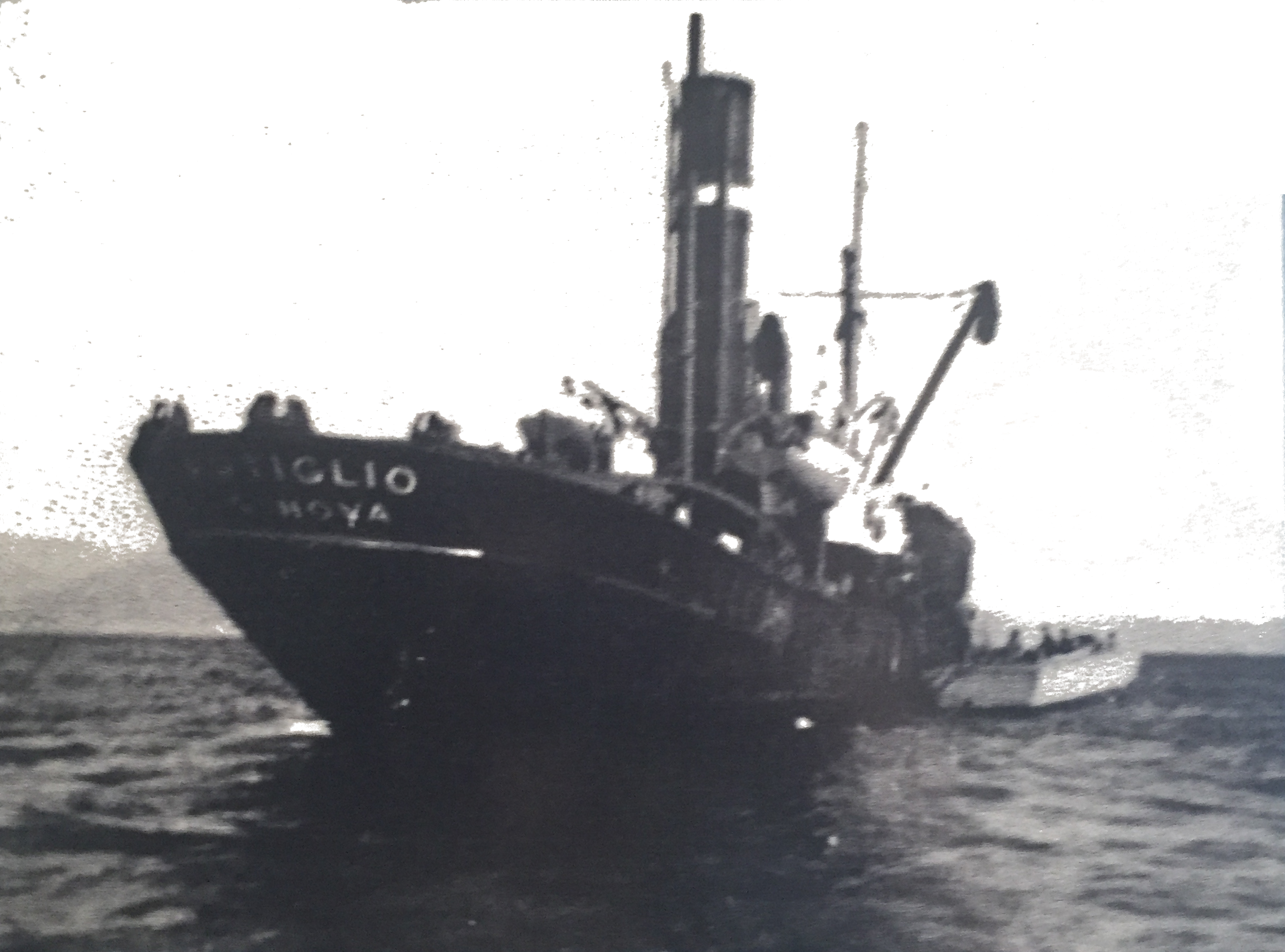 In Italy the first wreck destined to be object of systematic exploration was precisely the one of Albenga. This enterprise, which in fact marks the birth of
Mediterranean underwater archeology, started with the discovery, in the sea around Albenga, of Dressel 1B amphorae dispersed on the seabed and by the signal of
the local fisherman Antonio Bignone, who had fished out the first three amphorae already in 1925. This led to the larger discovery of a wreck of a Roman ship sunk about km.
1.5 from the coast. The first exploration of the wreck, realized by
In Italy the first wreck destined to be object of systematic exploration was precisely the one of Albenga. This enterprise, which in fact marks the birth of
Mediterranean underwater archeology, started with the discovery, in the sea around Albenga, of Dressel 1B amphorae dispersed on the seabed and by the signal of
the local fisherman Antonio Bignone, who had fished out the first three amphorae already in 1925. This led to the larger discovery of a wreck of a Roman ship sunk about km.
1.5 from the coast. The first exploration of the wreck, realized by 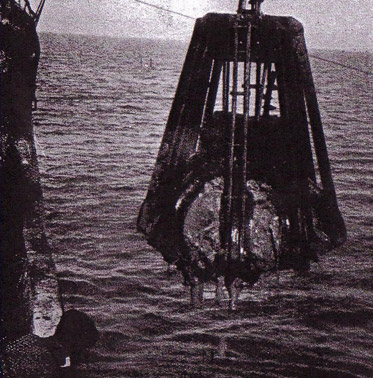 The enterprise had an enormous echo both among scholars and the general public, even beyond national borders,
despite the limited and inadequate means available at that time to the "Artiglio" divers and, in particular, the use of rudimentary tools like the bucket (i.e. the grasp, in the image on the left),
which caused damage to the wreck. In less than a month 728 amphorae constituting the main load were recovered, associated with piles of plates and black-glazed ceramic cups,
which traveled as accompanying goods placed in the voids between the amphorae.
The enterprise had an enormous echo both among scholars and the general public, even beyond national borders,
despite the limited and inadequate means available at that time to the "Artiglio" divers and, in particular, the use of rudimentary tools like the bucket (i.e. the grasp, in the image on the left),
which caused damage to the wreck. In less than a month 728 amphorae constituting the main load were recovered, associated with piles of plates and black-glazed ceramic cups,
which traveled as accompanying goods placed in the voids between the amphorae.

